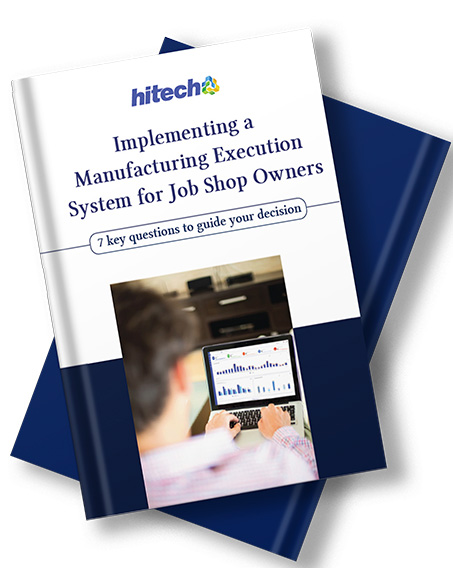- Manufacturing Execution System (MES) is critical for metal fabricators, addressing operational challenges through features like real-time production monitoring, workflow and order scheduling, and predictive maintenance.
- MES helps metal fabricators to track materials, optimize stock levels and implement just-in-time inventory practices to minimize waste.
- Effective integration with other systems enhances operational visibility and cross-departmental collaboration, thus improving overall efficiency.
Metal fabricators face operational challenges that can impact overall plant efficiency and the bottom line of their businesses. From the growing complexity of operations to the critical need for real-time data and analytics, fabricators are seeking solutions that can address these issues head-on. Manufacturing Execution Systems (MES) have emerged as a key technology, offering a suite of features designed to streamline production processes, enhance quality control and improve inventory management.
Table of Contents
- Key Operational Challenges Faced by Fabricators
- Top Features of MES to Enhance Operational Efficiency
- Workflow and Order Scheduling
- Real-Time Production Monitoring
- Inventory and Material Management
- Maintenance Management
- Integration Capabilities
- Process Control and Standardization
- User-defined Dashboards, Alerts, and Notifications
- Effective Labor Management
- Document Management
- Compliance and Reporting
- Conclusion
This article highlights essential MES features fabricators should look at to transform their operations from reactive to proactive, ensuring scalability and higher customer satisfaction.
Key Operational Challenges Faced by Fabricators
- Multiple, Siloed Data Sources: Sheet metal fabricators often utilize a variety of machines and software platforms, each generating data in different formats. Integrating this disparate data into a cohesive system for comprehensive analysis poses a significant challenge.
- Low Visibility into Shop Floor Activities: Low visibility into shop floor activities arises from data fragmentation across different sources, such as Excel spreadsheets and offline documents and systems. This fragmented data makes it challenging to obtain real-time insights and reports, hindering effective decision-making and capacity utilization.
- Quality Control Issues: The diversity and complexity of manufacturing operations make it difficult to maintain high-quality standards, especially when dealing with multiple product lines or custom fabrications.
- Understocking/overstocking of Inventory: Beside normal inventory issues faced by all manufacturers, sheet metal fabricators face challenges in maintaining precise stock levels for custom orders, material tracking, managing remnants for efficiency, aligning inventory with variable project timelines and coping with high volatility in material costs.
- Labor Management Issues: Managing a skilled workforce, addressing labor shortages, and ensuring efficient workforce utilization are key challenges.
Top Features of MES to Enhance Operational Efficiency
MES features ensure achieving efficiency over every aspect of the production process, from inventory management to quality control, fostering efficiency, reducing waste, and ensuring compliance. In this context, we present a detailed exploration of the key MES features, their underlying technologies, and the tangible benefits they bring to the fabrication shop floor.
 MES Features for Metal Fabricators
MES Features for Metal Fabricators
Workflow and Order Scheduling
Manufacturing Execution Systems (MES) offer fabricators advanced scheduling options, such as priority-based scheduling, forward scheduling, and backward scheduling. These techniques allow the recalibration of the production process in accordance with current capabilities and constraints to optimize workflow and order scheduling.
How does it work?
- Priority-based Scheduling: Fabricators can rank jobs based on importance, deadlines, or profit to prioritize urgent projects.
- Forward Scheduling: This method calculates the earliest possible finish time, starting as soon as possible to meet fixed start dates. It’s ideal for sectors requiring immediate production, such as doors and storage.
- Backward Scheduling: Used for tasks with strict deadlines, it determines the latest possible start time to ensure critical end dates are met, essential for constructions like awnings or cladding.
These scheduling options leverage advanced algorithms that account for various factors, including machine availability, labor skills, and material lead times, ensuring optimal order scheduling.
What is the impact?
Implementing these scheduling techniques via MES substantially enhances production efficiency, allowing fabricators to adjust quickly to new orders and minimize idle times. This adaptability is crucial for industries where production is often linked to client events or construction schedules. By prioritizing and efficiently managing resources, fabricators can accelerate production throughput, reduce operational costs by minimizing overtime and expediting fees, and increase customer satisfaction through timely deliveries.
Real-Time Production Monitoring
Real-time production monitoring enables fabricators to detect anomalies, machine failures, or production bottlenecks. This capability is particularly crucial for industries such as cabinet manufacturing, where precision and timing are key to maintaining high standards of production. MES systems provide a powerful layer of intelligence by integrating Internet of Things (IoT) technology, which facilitates the immediate identification and rectification of production issues.
 MES Features for Metal Fabricators
MES Features for Metal Fabricators
How does it work?
- Detection and Alerts: MES uses IoT sensors installed on machinery and equipment to continuously monitor and collect data on various parameters, such as operational performance, machine conditions, and production quality. When these sensors detect any deviation from the norm, such as a discrepancy in the dimensions of sheet metal cuts, they trigger alerts and notifications, enabling them to take swift corrective actions.
- Start / stop timers: These timers are started or halted based on data received from IoT (Internet of Things) sensors and user inputs. The help to accurately track the operational status of machinery and production processes.
- Issue escalation: Issue escalation promptly addresses and resolves issues that impact production efficiency. It begins with the detection of anomalies through IoT sensors, followed by an initial assessment to determine the problem’s severity. The issue is escalated based on predefined protocols to ensure it is addressed by experts, such as floor operators, engineering specialists, or management.
- Data Aggregation and Visualization: The data collected by IoT sensors is aggregated and analyzed by the MES. This information is then presented on custom interactive dashboards, providing real-time oversight and actionable insights into the production process.
What is the impact?
- Enhanced Operational Efficiency: Immediate detection and rectification of production anomalies allow fabricators to maintain continuous production flow and high equipment effectiveness. This not only prevents machine failures, but also optimizes the production process by reducing waste.
- Quality Control and Cost Reduction: For processes such as the fabrication of metal doors, real-time monitoring ensures that bending and cutting processes operate within specified tolerances, avoiding rework or scrap. This level of control directly contributes to higher-quality outputs and lowers production costs by minimizing waste and unnecessary downtime.
Explore the Full Potential of MES for Your Fabrication Needs
Learn more about our cutting-edge features designed to enhance efficiency, quality, and compliance.
Inventory and Material Management
Inventory and material management involves the strategic oversight and optimization of inventory levels, leveraging RFID (Radio-Frequency Identification) and barcode technologies. This feature is crucial for maintaining an efficient production line, especially for those specializing in custom projects like cladding, where material requirements can vary significantly from one job to the next. The aim is to implement just-in-time (JIT) inventory practices, a lean manufacturing principle focused on reducing excess stock and minimizing waste.
 MES Features for Metal Fabricators
MES Features for Metal Fabricators
How does it work?
- Tracking and Monitoring: RFID and barcode technologies are employed to meticulously track and monitor materials from receipt through to their use in production. This precise tracking capability enables fabricators to maintain real-time visibility over their inventory, tracking each sheet of metal, hardware component, or accessory.
- Insight and Optimization: MES analyzes the data collected through RFID and barcode scans. Fabricators gain detailed insights into material usage patterns. This information is crucial for optimizing stock levels and ensuring that the right materials are available in the right quantities at the right time, without overstocking or understocking.
- Automated Reordering: Integration with supply chain management systems allows for the automation of the reorder process. Based on actual inventory levels and production needs, materials are replenished dynamically, reducing the need for manual intervention and ensuring materials are available when needed.
What is the impact?
- Streamlined Production Process: By minimizing excess inventory, fabricators can streamline their production process, free up warehouse space, and reduce operational costs associated with storing unnecessary materials.
- Cost Reduction: Avoiding the purchase of surplus materials not only frees up capital, but also minimizes the costs associated with handling and storing unused inventory.
- Optimized Material Usage: For sheet metal fabricators, who often deal with a variety of materials, such as aluminum, steel, or copper, having a system that can dynamically adjust to production needs based on actual usage is invaluable. This ensures that each material type is used efficiently, reducing waste and controlling costs.
Maintenance Management
Maintenance management in manufacturing execution systems (MES) leverages predictive analytics and machine learning to forecast equipment failures before they occur. This advanced feature goes beyond merely predicting failures; it also automates the scheduling of preventive maintenance tasks to ensure they are conducted at the most optimal times.
How does it work?
- Predictive Analytics and Machine Learning: Utilizing historical and real-time data about the machinery’s performance and condition, these technologies identify patterns that indicate potential equipment failures.
- Automated Scheduling: MES automatically schedules maintenance activities at intervals that match the actual condition and usage patterns of the equipment. This means maintenance is performed only when needed, enhancing efficiency and preventing unnecessary downtime.
What is the impact?
- Minimized Unplanned Downtime: By predicting and preventing equipment failures before they happen, fabricators can reduce the costly interruptions associated with unexpected machinery breakdowns.
- Extended Equipment Lifespan: Predictive maintenance helps extend the lifespan of critical machinery by ensuring that maintenance is performed precisely when needed, reducing the need for expensive repairs or premature replacements.
- Enhanced Production Availability: By ensuring machinery is maintained optimally and remains operational, fabricators can uphold their production schedules, meet delivery commitments, and enhance customer satisfaction.
Integration Capabilities
Integration capabilities in manufacturing execution systems (MES) for fabricators are essential features that bridge informational gaps and enhance collaboration across various departments, including design, production, quality control, and supply chain management.
How does it work?
- Seamless Data Exchange: Through robust Application Programming Interfaces (APIs) and middleware, MES systems can exchange data seamlessly with other enterprise systems like ERP, CAD, and quality management software. This integration allows for the automatic adjustment of production schedules, material requirements and delivery timelines in response to new customer orders or changes in production capacity.
- Cross-Functional Collaboration: By enabling real-time communication between different departments, MES ensures that all relevant parties are immediately updated with changes or new information. For example, when a customer order is received, the MES can inform the design team to prepare the necessary specifications, notify the supply chain to secure materials, and adjust the production schedule accordingly.
What is the impact?
- 360-Degree Operational Visibility: Managers gain comprehensive insights into every aspect of the operation, from production status and inventory levels to quality metrics. This visibility supports better decision making, allowing managers to optimize resources, reduce waste, and respond more quickly to market demands.
- Enhanced Efficiency and Agility: By eliminating informational silos and improving collaboration across departments, fabricators can significantly enhance their operational efficiency. This agility is crucial for meeting customer requirements, adapting to changes in production demands, and maintaining a competitive edge.
Process Control and Standardization
Process control and standardization in manufacturing execution systems (MES) focus on creating a unified approach to fabrication operations. This feature ensures that all processes are carried out consistently and in accordance with predefined standards, significantly reducing variability and enhancing the repeatability of production tasks.
How does it work?
- Establishment of Standards: The MES system houses and disseminates standardized procedures and control plans for every aspect of the manufacturing process. These standards are designed to ensure that each step of production is executed in a consistent manner, regardless of the operator or shift.
- Consistent Execution: By integrating these standards directly into the daily workflow, MES ensures that all operators and shifts follow the same procedures, use materials and machinery in the same way, and adhere to the same quality checks. This standardization is enforced through the MES interface, where operators can access digital SOPs and control plans, guiding them through the correct execution of their tasks.
- Monitoring and Compliance: The MES continuously monitors operations to ensure compliance with the established standards. Any deviations from the set procedures are immediately flagged for correction, allowing for real-time adjustments and continuous process improvement.
What is the impact?
- Uniform Product Quality: Standardizing production operations ensures that every product meets the same high-quality standards, reducing the likelihood of defects and rework. This consistency is key to maintaining customer trust and satisfaction.
- Operational Reliability: With reduced variability in processes, fabricators can expect more predictable and reliable production outcomes. This reliability translates into better planning, reduced downtime and more efficient use of resources.
- Facilitates Continuous Improvement: Data collected through the MES can be analyzed to pinpoint inefficiencies or quality issues, driving continuous improvement efforts.

Implementing an MES for job shop owners
- Do you still manually plan production?
- Can you track and trace all manufacturing orders?
- How updated are your reports on machine availability?
- Ask many more questions like this to assess your job shop’s maturity.
User-defined Dashboards, Alerts, and Notifications
Ability to create user-defined and role-based dashboards, reports and notifications within a Manufacturing Execution System (MES) serve as a critical tool for fabricators. It leverages advanced technologies like AI, machine learning, and predictive intelligence to analyze vast amounts of production data. This functionality helps identify patterns, trends, and anomalies in the production process, enabling proactive management and optimization of manufacturing operations.
How does it work?
- Data Collection: MES collects data from various sources, including machine sensors, operational logs, and quality control checks. This data encompasses a wide range of information, from real-time machine performance to production efficiency and product quality metrics.
- Advanced Analysis: Utilizing big data analytics, AI, and machine learning, the MES analyzes the collected data to identify patterns, predict trends, and flag potential issues before they become significant problems.
- Customized Reporting: The system generates various reports and notifications tailored to the needs of different stakeholders in the organization. For example, floor managers may receive real-time alerts on machine performance, while senior management might receive weekly summaries of production efficiency and operational health.
- Proactive Notifications: In addition to regular reports, the MES can send real-time alerts and notifications to prompt immediate action. This could involve alerting maintenance teams to potential equipment issues, notifying production managers of supply chain disruptions, or informing quality control of deviations in product quality.
What is the impact?
- Enhanced Decision-Making: By providing relevant decision-makers with right insights at the right time, MES enables more informed strategic planning and operational adjustments. This data-driven approach leads to significant improvements in production performance and efficiency.
- Increased Operational Efficiency: Identifying patterns and trends allows for process optimization, minimizing waste, and enhancing productivity. Predictive maintenance alerts, for instance, can reduce unplanned downtime and extend the lifespan of critical equipment.
Effective Labor Management
Labor management represents a sophisticated feature designed to streamline workforce allocation, improve labor productivity, and enhance operational efficiency. This feature addresses the traditional manual processes of attendance taking, role assignment, and task distribution by automating these processes.
How does it work?
- Automated Workforce Allocation: Supervisors can input employee availability, including planned absences, into the system, which then automatically adjusts workforce allocation based on current production requirements. This includes determining how many workers are needed at each machine or workstation and assigning tasks based on the available personnel and their skills.
- Digital Time Tracking and Performance Monitoring: MES employs digital tools to track labor productivity, monitoring each worker’s performance against predefined benchmarks and standards. This not only includes tracking the hours worked, but also evaluating the quality and efficiency of the work performed.
- Data-Driven Workforce Planning: The system uses data from various sources, including past performance, current work orders, and machine requirements, to create an efficient plan that optimizes labor allocation. This planning takes into account the specific needs of different workstations and the orders being processed, ensuring that the right number of skilled workers is available where they are most needed.
What is the impact?
- Increased Operational Efficiency: By automating the process of workforce allocation and task assignment, MES significantly reduces the time and effort required by supervisors for daily planning.
- Optimized Labor Costs: Effective labor management helps to align labor resources with production needs more effectively, reducing overstaffing or understaffing situations.
- Enhanced Workforce Productivity: With targeted training and adjustments based on performance monitoring, workers can improve their skills and efficiency, leading to higher productivity levels.
- Improved Capacity Utilization: Automated labor management ensures that workforce planning is closely aligned with production needs and machine requirements. This alignment leads to improved capacity utilization.
Document Management
Document management in manufacturing execution systems (MES) helps optimize the handling, distribution, and revision control of critical documents in manufacturing operations. This feature is essential for managing the vast array of documentation associated with product specifications, engineering drawings, quality records and revisions.
How does it work?
- Centralized Storage: MES provides a single digital platform for storing all manufacturing-related documents, ensuring they are easily accessible and up to date.
- Revision Control: It tracks changes and revisions to documents, ensuring that all personnel are working from the latest versions.
- Easy Access: Digital documents are accessible to relevant personnel at any time, eliminating the need for physical copies and reducing the risk of using outdated information.
What is the impact?
- Cost Savings: Reduces the need for physical document storage and handling, saving time and resources.
- Compliance: Enhances compliance with industry standards by maintaining a complete, traceable record of all documents and revisions.
- Improved Collaboration: Facilitates better communication among teams by providing a central repository for all documents.
Compliance and Reporting
Compliance and reporting in MES simplifies the process of adhering to these standards by providing accurate and timely reporting and record-keeping. This feature automates the generation, tracking, and storage of critical compliance documents—including audit trails and quality reports.
How does it work?
- Document Management: MES systems manage a wide array of documents required for compliance, from safety certifications to quality assessments. This centralized document management ensures that all necessary paperwork is up-to-date and easily accessible.
- Traceability: The system tracks every aspect of the production process, from who worked on what, to what materials were used, and where those materials were procured. This level of traceability is essential for identifying and addressing issues quickly.
- Automated Reporting: Utilizing real-time data captured through IoT devices and other sources, the MES automates the generation of compliance reports. This automation extends to record-keeping requirements, ensuring that manufacturers can easily demonstrate adherence to industry standards and regulatory requirements.
What is the impact?
- Enhanced Regulatory Compliance: By automating record-keeping and reporting, MES ensures that manufacturers can meet regulatory standards and customer requirements more efficiently, reducing the risk of fines and other penalties.
- Improved Reputation: Maintaining compliance helps protect the manufacturer’s reputation by ensuring that products are safe and reliable. This is particularly important in industries where noncompliance can have serious implications for both users and the manufacturer.
- Dispute Avoidance: The detailed records kept by MES provide manufacturers with the evidence needed to resolve disputes over quality or compliance, whether with customers or suppliers.
Conclusion
As metal fabricators navigate the complexities of modern manufacturing, the adoption of a robust Manufacturing Execution System (MES) stands out as a strategic imperative. MES software for sheet metal fabricators delivers a robust and comprehensive solution, specifically designed to tackle the unique challenges of the industry. With the right MES features, fabricators can not only survive, but thrive in a competitive landscape, ensuring they remain agile and ahead of the curve.
Upgrade Your Metal Fabrication with MES Technology
Ready to optimize your shop floor and streamline operations?





